Ancient art is more than just paintings and sculptures. It is a glimpse into the past, revealing how early civilizations expressed their beliefs, culture, and way of life. From towering pyramids in Egypt to delicate Greek pottery, these artworks tell stories that have lasted for thousands of years.
But what makes ancient art so important? It shaped modern creativity, influenced architecture, and even inspired today’s ancient art tattoos. Every brushstroke and carving had a purpose, whether to honor gods, record history, or express emotions.
Throughout history, different regions developed their own unique styles. Greece’s ancient art focused on human beauty and balance. Egyptian ancient art emphasized gods, pharaohs, and the afterlife. Chinese and Japanese ancient art celebrated nature and spirituality.
Today, museums worldwide work hard to preserve these priceless creations. The Museum of Ancient Art and other institutions are digitizing artworks to keep their legacy alive. But some pieces face challenges like erosion, theft, and repatriation debates.
This article explores the origins, techniques, and hidden meanings behind ancient art. It will also reveal how these masterpieces continue to influence our world.
1. The Origins of Ancient Art: The First Creative Expressions
The earliest forms of ancient art date back thousands of years, long before written language. Early humans used art to communicate, document their surroundings, and express their beliefs. These first artistic expressions laid the foundation for later civilizations.
Prehistoric Cave Paintings: The First Artworks
One of the oldest known art forms is cave painting. These stunning images, found in places like Lascaux (France), Chauvet (France), and Altamira (Spain), depict animals, hunting scenes, and mysterious symbols. Many were created over 17,000 years ago using natural pigments like charcoal and ochre.
But why did early humans create these paintings? Some experts believe they were used for spiritual rituals, while others think they were a way to teach hunting techniques. Either way, these artworks prove that creativity existed long before modern civilization.
Rock Art and Petroglyphs: The Earliest Symbols
Aside from cave paintings, early humans also carved images into stone and rock surfaces. These carvings, called petroglyphs, have been discovered across the world, from North America to Africa and Australia.
Petroglyphs often feature geometric patterns, human figures, and animals. Some researchers believe they had religious significance, while others suggest they were early forms of storytelling.
First Sculptures: Venus Figurines and Early Carvings
Another early form of ancient art includes small stone figurines. Some of the most famous examples are the Venus figurines, carved between 30,000 and 25,000 BCE. These sculptures, found across Europe, depict female figures with exaggerated curves.
Historians believe these figurines symbolized fertility, beauty, or religious devotion. Their purpose remains a mystery, but they prove that ancient people saw art as more than just decoration—it was meaningful.
How These Early Art Forms Influenced Later Civilizations
These early artworks set the stage for later artistic movements. The techniques used in cave paintings evolved into frescoes in Ancient Greece. Petroglyphs inspired hieroglyphics in Ancient Egypt. Even today, echoes of prehistoric carvings can be seen in modern ancient art tattoos.
These first artistic expressions show that humans have always sought to create, communicate, and connect through art.
2. The Hidden Messages in Ancient Art
Ancient art was more than just decoration. It was a powerful storytelling tool. Every symbol, color, and design carried a deeper meaning. Whether painted on walls or carved in stone, these artworks helped people express their beliefs, record history, and honor their gods.
Storytelling Through Pictographs and Petroglyphs
Before written language, people used pictographs—simple drawings that represented ideas. These symbols appeared in cave paintings, rock carvings, and early scripts. Some of the most famous pictographs include:
- Egyptian hieroglyphs – A complex system of symbols used to record history.
- Mayan glyphs – Intricate carvings that told stories of kings and gods.
- Native American petroglyphs – Rock carvings used to document rituals and important events.
These early visual stories laid the groundwork for modern writing. Many cultures later developed full alphabets inspired by ancient symbols.
Religious and Mythological Themes in Ancient Art
Ancient civilizations often used art to honor gods and explain the universe. In many cases, religious figures and mythical creatures were the main subjects of paintings, sculptures, and murals.
- Greek art depicted gods like Zeus and Athena in human form.
- Egyptian art used detailed carvings to show the journey to the afterlife.
- Chinese and Japanese ancient art included dragons, phoenixes, and spirits to represent balance and power.
These artworks were not just for admiration. They played an important role in rituals, ceremonies, and temples. Some pieces even served as protection, believed to bring good fortune or ward off evil.
Depictions of Daily Life and Ancient Traditions
Not all ancient art was about gods and myths. Many pieces captured everyday life, showing how people worked, played, and celebrated.
- Greek pottery often showed scenes of warriors, athletes, and family gatherings.
- Egyptian tomb paintings depicted farming, fishing, and feasts.
- Mesoamerican murals recorded important events like royal ceremonies.
These artworks give historians valuable insights into how people lived thousands of years ago. They also show that, despite the time gap, humans have always valued family, storytelling, and self-expression.
The Lasting Influence of Symbolism in Modern Art
Even today, many symbols from ancient art appear in modern designs, tattoos, and architecture. Artists and designers continue to draw inspiration from the past, proving that the messages hidden in ancient art still speak to us today.
3. Artistic Styles Across Ancient Civilizations
Every ancient civilization had its own unique artistic style. From the grandeur of Egyptian monuments to the delicate beauty of Japanese ink paintings, ancient art reflected the culture, beliefs, and craftsmanship of its time.
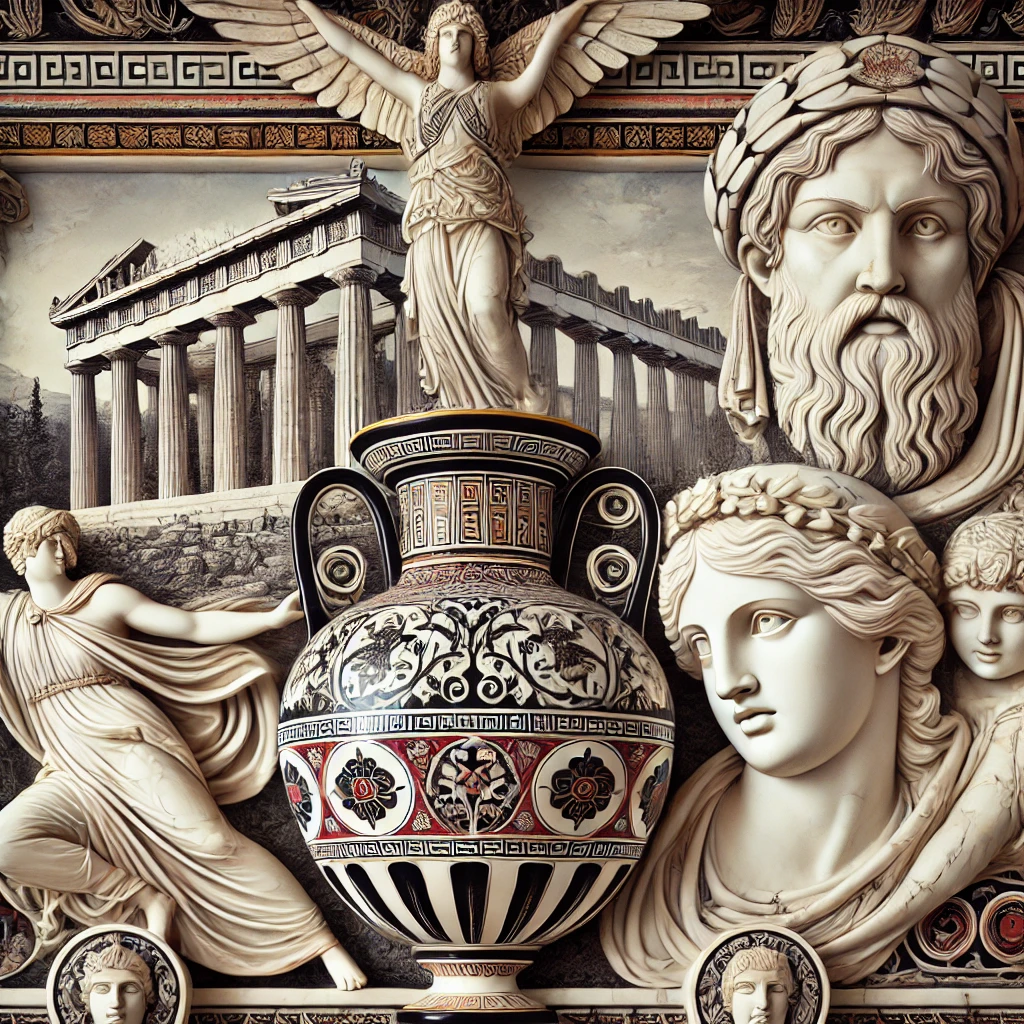
Greek Ancient Art: The Pursuit of Perfection
Greek ancient art was known for its focus on balance, beauty, and realism. The Greeks aimed to capture the perfect human form, often portraying gods, athletes, and warriors in idealized proportions.
- Sculptures – Famous works like the Venus de Milo and Discobolus (the Discus Thrower) showcased detailed, lifelike figures.
- Pottery – Greek vases depicted mythological stories, daily life, and sporting events.
- Architecture – Structures like the Parthenon emphasized harmony and symmetry.
Greek art influenced Roman sculptures, Renaissance artists, and even modern architecture.
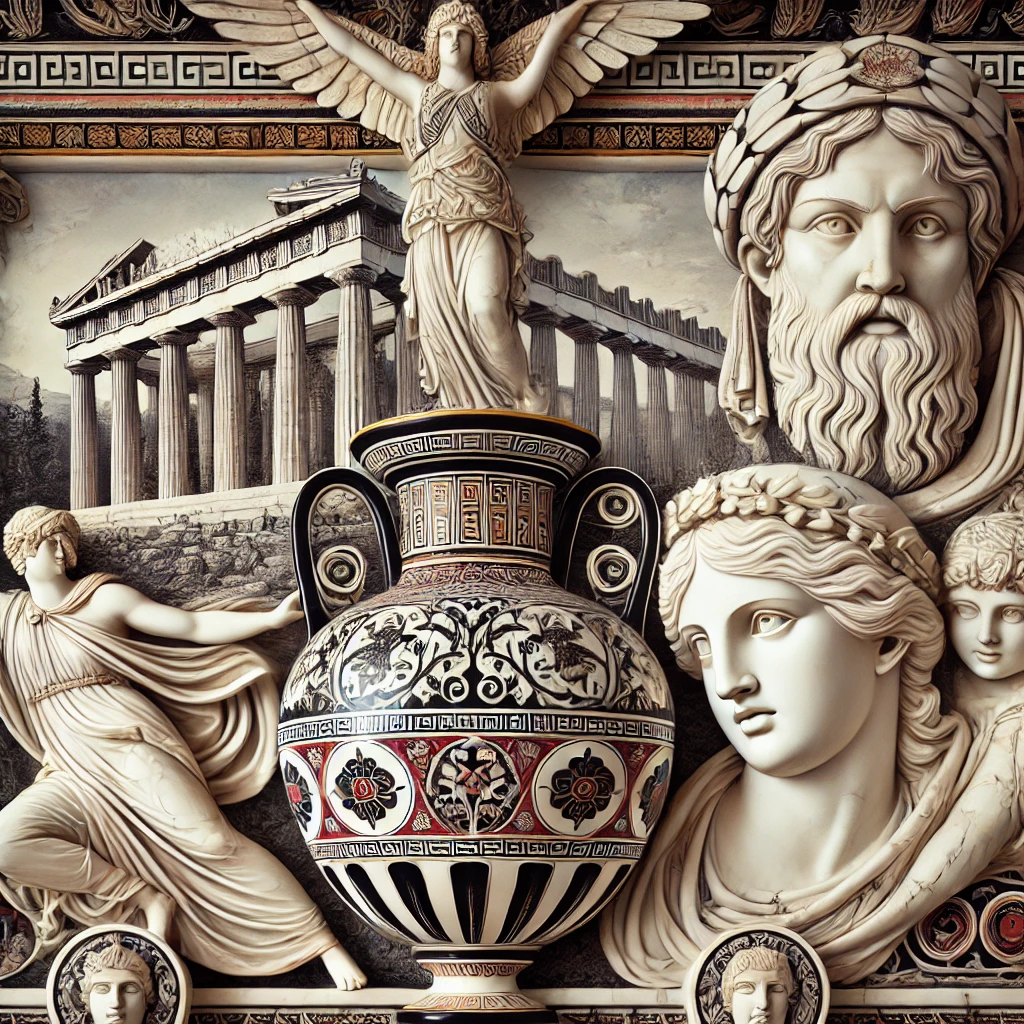
Egyptian Ancient Art: Symbolism and the Afterlife
Ancient Egyptian art was deeply connected to religion and the afterlife. It followed strict rules, ensuring that figures were depicted in a timeless, recognizable way.
- Hieroglyphics – A combination of symbols and drawings used for communication.
- Wall paintings – Found in tombs and temples, showing gods, pharaohs, and daily life.
- Sculptures – Statues of pharaohs, like the famous Great Sphinx of Giza, symbolized power and divine rule.
Egyptian art was not about realism but about storytelling and preservation. The goal was to ensure the afterlife of those portrayed in the artwork.
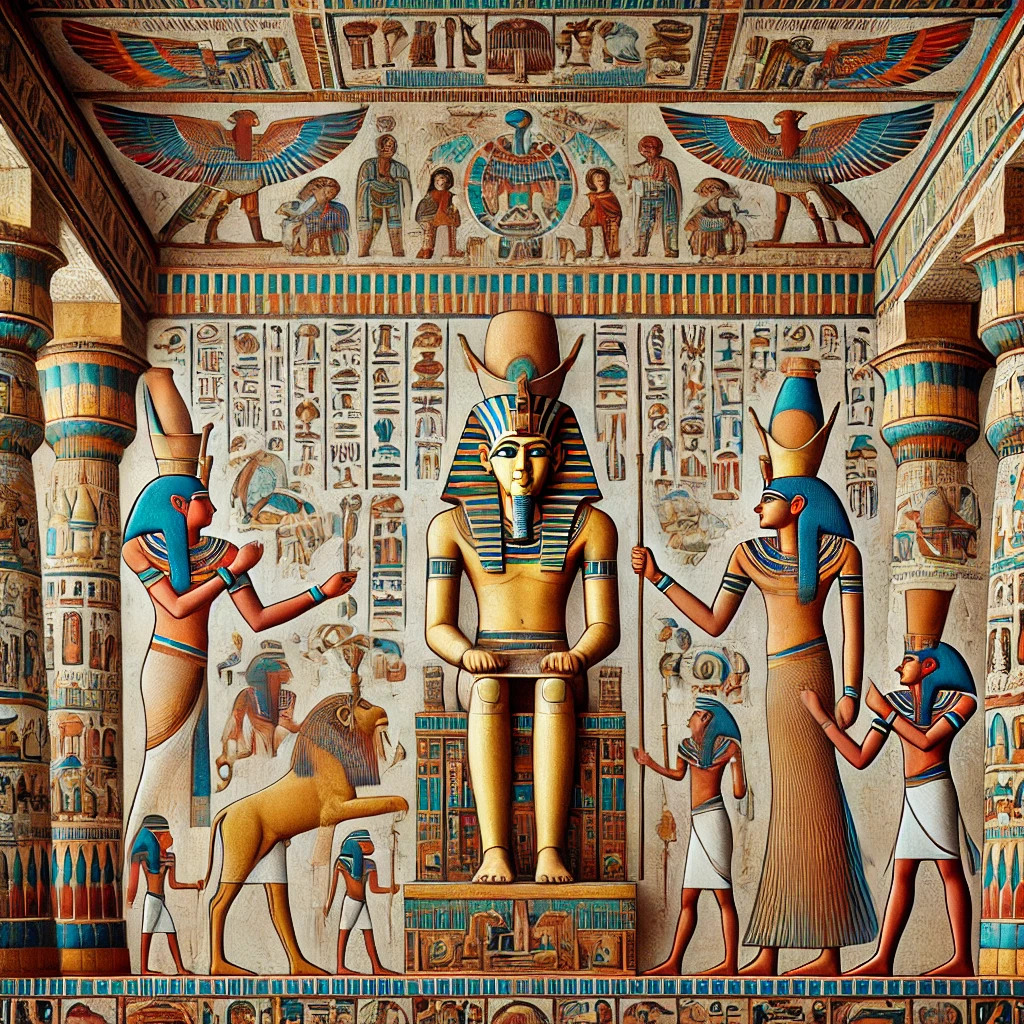
Chinese Ancient Art: Nature and Spirituality
Chinese ancient art emphasized harmony, balance, and nature. It often reflected Confucian, Taoist, and Buddhist philosophies.
- Calligraphy – Considered one of the highest forms of art, showcasing elegance and emotion through brushstrokes.
- Silk paintings – Delicate artworks featuring landscapes, animals, and mythical creatures.
- Porcelain and pottery – Exquisite ceramics, like the famous blue and white porcelain, became highly valued worldwide.
Chinese art had a lasting influence on Japanese and Korean art and modern minimalist design.
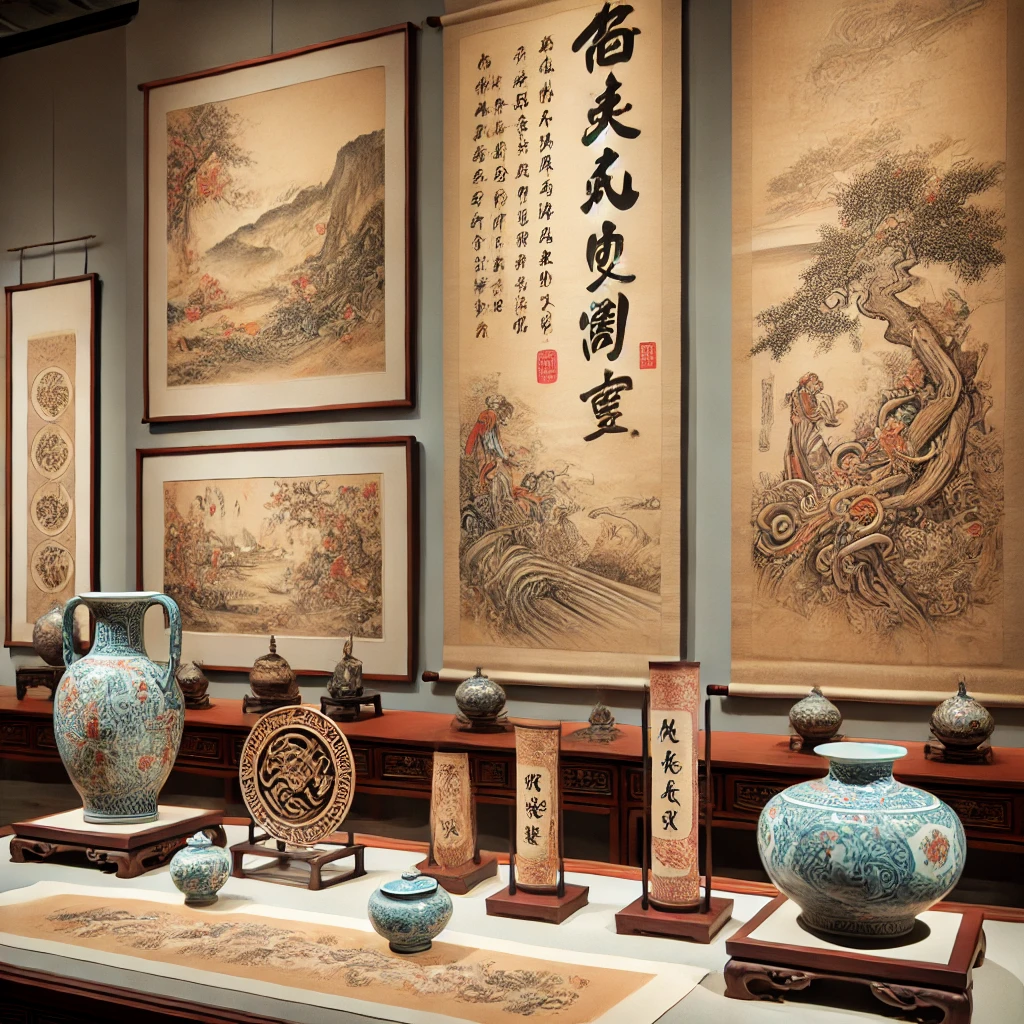
Japanese Ancient Art: Simplicity and Detail
Japanese ancient art focused on natural beauty and spiritual themes. Many artworks were inspired by Zen Buddhism and Shinto beliefs.
- Woodblock prints – Artworks like The Great Wave off Kanagawa became iconic worldwide.
- Ink paintings – Simple yet expressive brushwork depicting landscapes and animals.
- Samurai armor and weapon art – Intricately designed swords and armor combined beauty with function.
Japanese ancient art continues to influence tattoo culture, interior design, and contemporary illustration.
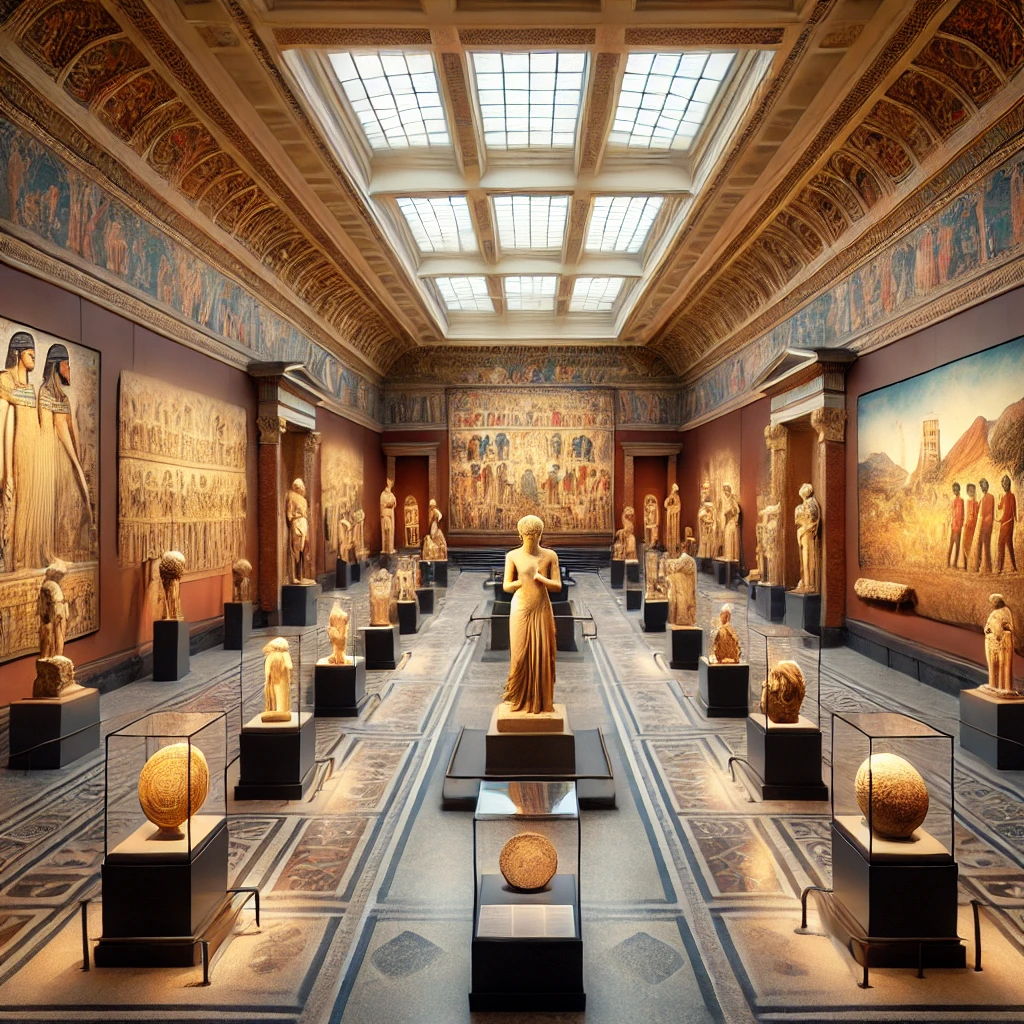
The Influence of Ancient Art on Museums and Modern Design
Many museums, like the Museum of Ancient Art, house these incredible artworks, preserving their beauty for future generations. Ancient styles also influence tattoos, fashion, and even modern architecture.
Each civilization left a distinct artistic legacy, but all shared one thing: a deep desire to express their world through art.
4. The Role of Ancient Art in Modern Culture
Ancient art continues to influence our world today. From museum exhibits to modern tattoos, these timeless creations shape our understanding of history, beauty, and storytelling.
Ancient Art in Museums and Exhibitions
Many of the greatest artworks from ancient civilizations are preserved in museums around the world. These institutions help preserve history by displaying past sculptures, paintings, and artifacts.
- The Met Museum – Houses a vast collection of Egyptian, Greek, and Near Eastern art.
- The British Museum – Famous for the Rosetta Stone and Parthenon sculptures.
- Museum of Ancient Art – Showcases artworks from various civilizations, including Chinese and Japanese pieces.
Visiting these museums allows people to experience ancient cultures firsthand. They provide valuable insights into how art evolved and influenced modern creativity.
Ancient Symbols and Designs in Modern Tattoos
Many people today choose ancient art tattoos as a way to honor history, mythology, and personal beliefs. Some of the most popular ancient designs include:
- Egyptian symbols – The Eye of Horus, Ankh, and scarab beetle represent protection and eternal life.
- Greek mythology – Tattoos of Zeus, Medusa, and Spartan warriors symbolize strength and power.
- Chinese and Japanese art – Designs featuring dragons, koi fish, and samurai represent wisdom, courage, and perseverance.
These tattoos show how ancient art continues to inspire personal expression and identity.
The Lasting Influence of Ancient Art on Modern Design
Ancient art has also shaped modern architecture, fashion, and digital design.
- Architecture – Many government buildings use Greek and Roman columns to symbolize strength and democracy.
- Fashion – Egyptian gold jewelry and Greek draped clothing styles still influence modern trends.
- Graphic design – Artists incorporate ancient symbols and hieroglyphs into digital artwork and branding.
The timeless beauty of ancient art proves that creativity knows no boundaries. Even as styles change, the influence of past civilizations remains strong.
Why Ancient Art Still Matters Today
Ancient art is more than just relics from the past. It tells stories, preserves traditions, and connects us to our ancestors. Whether in museums, tattoos, or modern designs, these artworks continue to shape our world in ways we often don’t realize.
By studying and appreciating ancient art, we gain a deeper understanding of human history and our shared cultural heritage.
5. Conclusion: The Timeless Legacy of Ancient Art
Ancient art is more than just a reflection of the past—it’s a bridge between history and modern culture. From the grand temples of Greece to the delicate ink paintings of Japan, these artworks tell the stories of civilizations that shaped the world we live in today.
A Lasting Influence on Creativity and Expression
The influence of ancient art is everywhere. It’s in the architecture of modern buildings, the symbols used in tattoos, and the timeless patterns in fashion and design. Many artists still draw inspiration from the beauty, craftsmanship, and storytelling of ancient civilizations.
Preserving and Appreciating Ancient Art
Museums, historians, and artists continue to work hard to preserve and study these masterpieces. Whether through exhibitions, digital reconstructions, or artistic reinterpretations, the legacy of ancient art remains alive.
Why Ancient Art Matters Today
Understanding ancient art helps us appreciate how human creativity has evolved. It reminds us that, across time and cultures, people have always used art to express beliefs, tell stories, and leave their mark on history.
As we continue to create, innovate, and explore new forms of artistic expression, ancient art serves as a reminder that true artistry stands the test of time.
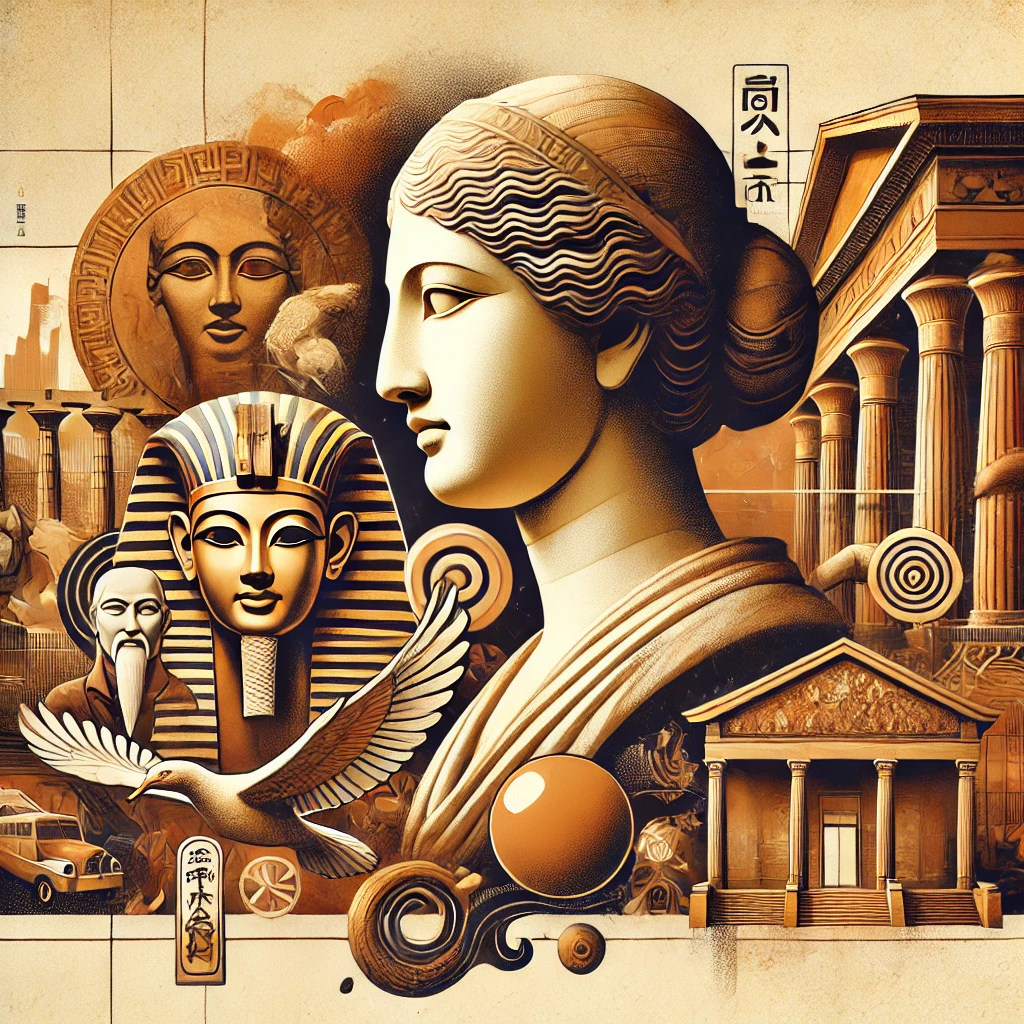

1 thought on “Ancient Art Explained: History, Symbolism & Modern Impact”